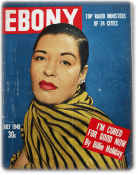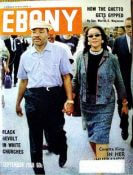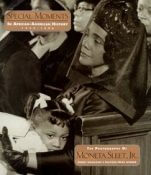It was the mid-nineties and I was ten. I sat under the hairdryer at my great-aunt’s beauty shop. The gossip of old friends, sounds of laughter, the sight of steam emitting from curling irons and blow dryers made the one-room salon put off a hazy glow.
The hair dryer was an ordeal because it took hours to dry my hair, and as a ten-year-old girl who would rather have been playing outside, I wanted nothing more than to have my hair finished. What got me through those Saturdays at The Beauty Shop were the magazines that my aunt supplied. Ebony, Essence, Jet, Hype Hair and Sophisticate’s Black Hairstyles, just to name a few. These magazines shaped how I viewed myself and the world around me. I was able to see a reflection of the brown-skinned young lady that I was, and that meant everything.
While all those magazines are important, Ebony was the one that made the most impact.

It was established on this day in 1945 by John Harold Johnson with a mission to show the African-American experience through photos and prose. Over the years, the magazine has featured celebrities such as Billy Dee Williams and Beyoncé and political figures such as Shirley Chisholm and President Barack Obama. The magazine has also covered tough topics, as in the August 1970 issue entitled “Which Way Black America? Separation? Integration? Liberation?” and a more recent issue that addressed if Barack Obama was right for black America.
Even in the 21st century, Ebony holds true to its original concept: to bring forth an awareness of issues the black community faces, to put people of color in a major periodical (something that has taken much too long with other mainstream magazines) and to show the black community in a positive light.
Many of the covers from the past are iconic enough to frame.

Take the July, 1949 issue (pictured above). Billie Holiday graced the cover with cherry red lips and slicked-back hair. The cover reads “I’m Cured for Good Now.” In the article, Holiday spoke about her struggle with narcotics, her road to recovery and the tough battle she fought to make it back to a career of singing.

In February 1968, the magazine’s cover featured Martin Luther King Jr. and his wife, Coretta Scott King, walking hand in hand. The eight page article titled “In Her Husbands Footsteps” highlighted Coretta Scott King’s role in the Poor People’s Campaign of 1968, which included the Solidarity Day March on June 19th, 1968 (Juneteenth). At the Lincoln Memorial, with over 50,000 people in attendance, Coretta Scott King’s aim was for people to speak out when they see the “triple evils of our time:” racism, poverty and war.

Many of Ebony’s iconic photographs were taken by Moneta Sleet Jr., a Pulitzer Prize Winner. Many of his photos are still used in telling the African American narrative, such as Coretta Scott King holding her daughter at her husbands funeral; a group of teenage girls in Nigeria witnessing the transfer of power from Britain to the Nigerian government; and Dr. Ronald McNair demonstrating his skill in martial arts in a 1979 issue (he would later be killed in the Space Shuttle Challenger explosion in 1986). These photos and more can be found in Special Moments in African-American History (1955-1996): The Photographs of Moneta Sleet, Jr.
Without Ebony, many of these moments could have gone uncaptured and these stories untold. What do you think makes this magazine successful? Tell us in the comments!
-Brittany
Explore This Iconic African American Magazine
Read an Issue of Ebony at Your Local LibraryBrittany is a Children’s Library Assistant at Main, where she enjoys reading stories, singing songs and ending her story times in a multitude of bubbles. Reading isn’t her only love; she also enjoys writing for children and adults alike.
